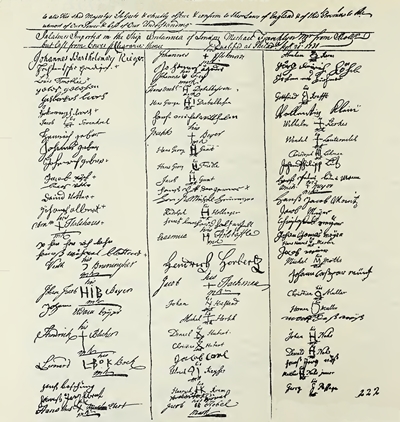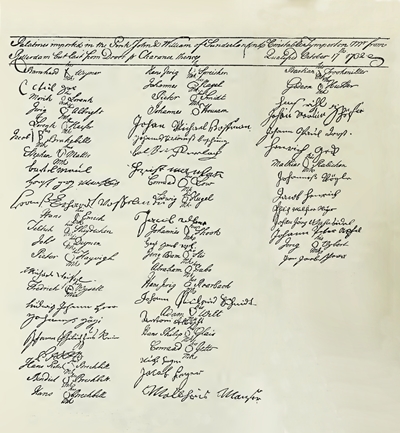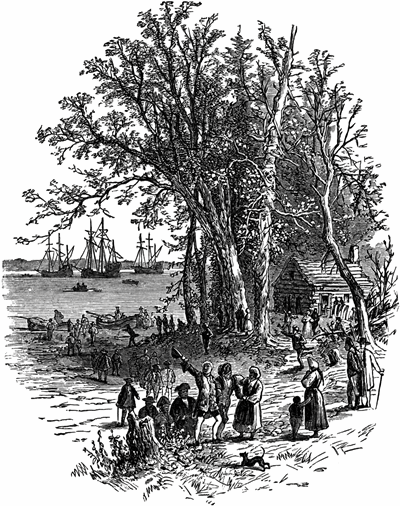














|
|
The History of the
American Immigrant Bushong Family
By Rick Bushong
First published: 2012
Expanded: April 2019
|
William Penn first landed in Pennsylvania in 1682. The first Bushong landed in about 1719.
|
|
History Forgotten is History Lost
The history of the Bushong family in America had been lost. Over the years and decades of neglect and forgetfulness, it became shrouded in mystery and layers of misinformation. Generations of Bushong family historians and genealogist have endeavored to pull back these shrouds that have robbed descendants of their own heritage. Sometimes advancing and others side-tracked by misinformation. It is no surprise that rediscovering it was difficult, considering that within just three or four generations, the immigrant's descendants had completely forgotten their German, and more specifically their Swiss-German heritage. This in spite of earliest family tombstones in the Bushong cemeteries being carved in German, not to mention German books being passed down in the family.
Forgetting made it easy to accept the mistakes that were bound to happen and followed. Each of them compounding upon each other, they began in 1844 when Prof. Daniel Rupp wrote in a widely read book that the 1731 immigrant, John Bushong was from France and a French Huguenot. Prof. Rupp was wrong, and though he subsequently included Bushongs (Boschungs) in his later books, he never repeated the mistake. In 1901 Amon Stapleton added to it, when he wrote in his book John Bushong is a French Huguenot named Jean Beauchamp, and again, he was wrong Then by 1928 genealogist and Bushong descendent, Mary Bessie Feller-Wickes had found her Jean Buchain in Strasbourg, France, married to Barbara "Foltz de Hagenau". That was enough for her and she added the "Foltz de Hagenau" to the growing Jean Beauchamp lore. Not only that, but she was a prolific letter writer and told every Bushong she could find. But she was wrong too.
Through a convoluted series of mistakes and false assumptions, the Bushong family came to believe they arrived in America as French Huguenots. It is no wonder that most Bushongs accepted and believed their ancestor was an imaginary Frenchman named Jean Beauchamp. But how ironic that the reality is not only simpler, it is more inspiring and if you will, elegant.
The German Bushongs
|
 The ship Brittania Oath of Allegiance, September 21, 1731. Hans signed in the left row, third from the bottom. A separate list notes Hans age 39, Barbara age 37, and their children, Magdelen age 11, Hans Phillip age 9, Ana Barbara age 6, Christiana age 3.
The ship Brittania Oath of Allegiance, September 21, 1731. Hans signed in the left row, third from the bottom. A separate list notes Hans age 39, Barbara age 37, and their children, Magdelen age 11, Hans Phillip age 9, Ana Barbara age 6, Christiana age 3. |
|
Simply put, their name was "Boschung" and in America these immigrants were known as the Pennsylvania Dutch. They were never French and never Huguenots. The "Dutch" in this case, is of course the anglicized word, "Deutsch", meaning German.
The first Boschung immigrant was John Buschong (Hans Boschung, III) and he arrived in Pennsylvania sometime before 1719. It would take another twelve years but in 1731 his son Hans "John" (IV) followed and then Johann Nicholas in 1732. They called themselves Boschung which we know because, on arrival both sons, between them, wrote their name and spelled it that way four times. In their own hand, written confidently, and clearly in old script.
Incidentally, it is easy to see, from the remarkable similarities between their signatures, that the two learned their German Kurrent alphabet in the same place, if not the same school and teacher. It also can be concluded that the brothers, learned to write in German schools and not Swiss. The German Kurrent script, unlike German-Swiss and English, uses a small "b" for a capital "B." This of course, would clear up any mystery as to why they both signed their last name with, what in the English language is a small "b."
To dwell on their signatures a bit further, the German letter most like a capital "B" in English is used for a different sound. It is called an "eszett" and it is written like ß and has the sound of a "sharp S." Notice, both Hans and Nicholas use an eszett in their names? It indicates that Hans' name should be pronounced with a sharp "s" but for American genealogists, "Hans" is often mispronounced Hanz, with a zz sound.
However, living in Colonial America, the Boschung family, as many did, anglicized the spelling of their German-Swiss surname, and eventually settled on Bushong and its variant, Bushon. To listen to "Boschung" with a German pronunciation, click here
|
Origin of the Bushong family
The surname Boschung originated in Switzerland, and was first noted in the 1520s in Jaun, which is in the canton of Fribourg. A few miles away and a decade later, in the 1530s, Boschungs start to be noted in the canton of Bern. They were Deutschschweizer or German-speaking Swiss who while being Swiss, spoke a German dialect called Swiss German. The Swiss inhabitants of those German speaking areas are generally descended from the Germanic Tribes known as the Alemanni. In the Protestant canton of Bern, which is where ancestors of the Colonial immigrant Boschungs originated, the dialect is further differentiated as Bärndütsch which translates to Bernese German. As mentioned above, the Bushong family's German language use is also illustrated in documents and on tombstones.
However, the Boschung familial lines of Jaun and early Bern are not the same as what would become the American Bushong family. The Colonial immigrant Boschung are from a different line than these two earlier Boschung families. It began in 1595, when Michael Studer and Dichtli Jaggi, had their son Peter Boschung, in Boltigen, Switzerland. Then in 1600, Hans Boschung I was born. It is his line that American Bushongs descend from. The father and progenitor, Michael Studer mysteriously changed his name to Hans Boschung. We know this because in 1598 a cleric recorded Michael's and Dichtli's marriage in the church book and noted his name was changed from Studer.
|
|
The Flag of Switzerland.
|
|
From Switzerland to Germany to America
|

The Pink John and William's" Oath of Allegiance, October 17, 1732. Nicholas' signature is center row, sixth from the top.
|
|
Following Michael, three more generations of Boschungs were born in Switzerland. Then the next generation in the Bushong's line, was born in Germany. They are the two immigrants, Hans Boschung IV and Johann Nicholas Boschung, who are the great great grandsons of Michael Studer.
From that point, genealogy has connected virtually every Bushong in America to these two. Later, as would be expected, when their descendants were DNA tested, it predicted, with a high degree of certainty, (95%) that the two were brothers. When this is considered with the known incidents of interactions between the two families, and other evidence, it creates a powerful argument and a strong foundation for the entire American Bushong family, descending from two brothers, Hans and Nicholas, which is the case.
Hans and Johann Nicholas were German Protestants, likely born in Minfeld, Rheinland-Pfalz, Germany, however church records are still being searched. Their father, Hans "John" Boschung (III), had left the Simmental Valley in the Bernese Oberland of Switzerland, where the family line originated. After immigrating to Germany where he had a family, he sailed to Pennsylvania sometime before 1719.
He was the first Bushong in America and he lived and had a plantation in Chester County, Pennsylvania, that he passed on to his sons. The area later became Lancaster County, before the two brothers settled there. There they were members of the Dutch (German) community, and attended Salem Hellers Reformed Church and other local Lutheran or Reformed Churches.
|
The rest, as they say, is history. But if you are interested in Bushong or are one of the thousands of descendants, don't take my word for it. There is so much more to the story and numerous articles about this family. Virtually all that I have been able to discover and put together, is on this website. All meticulously researched, documented, and footnoted, it has taken years to study and will take time to read and see what all is here. I hope you think it is worth it.
Rick Bushong
|





